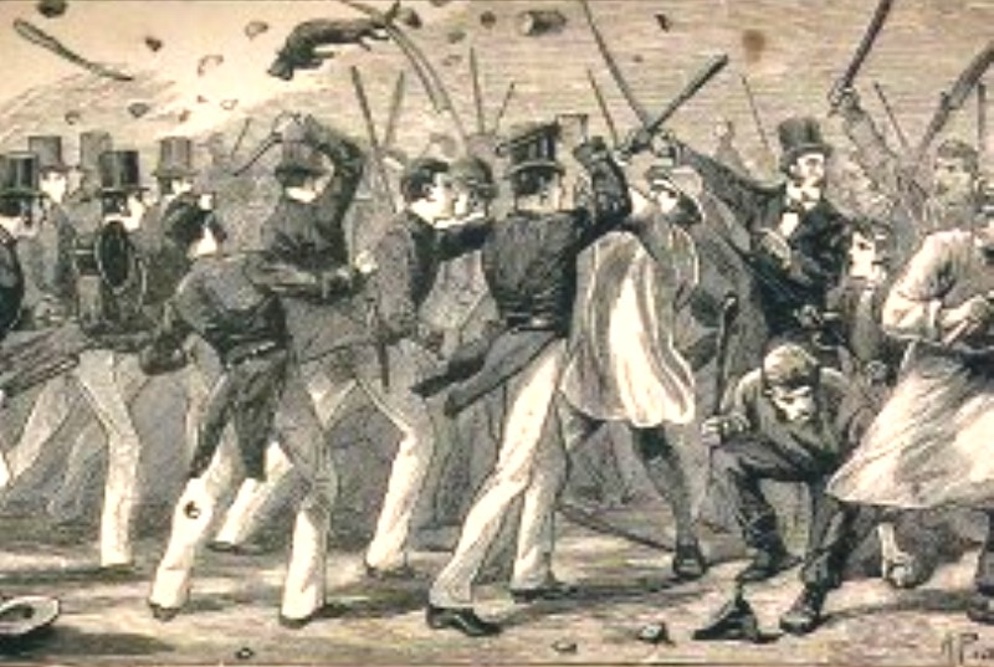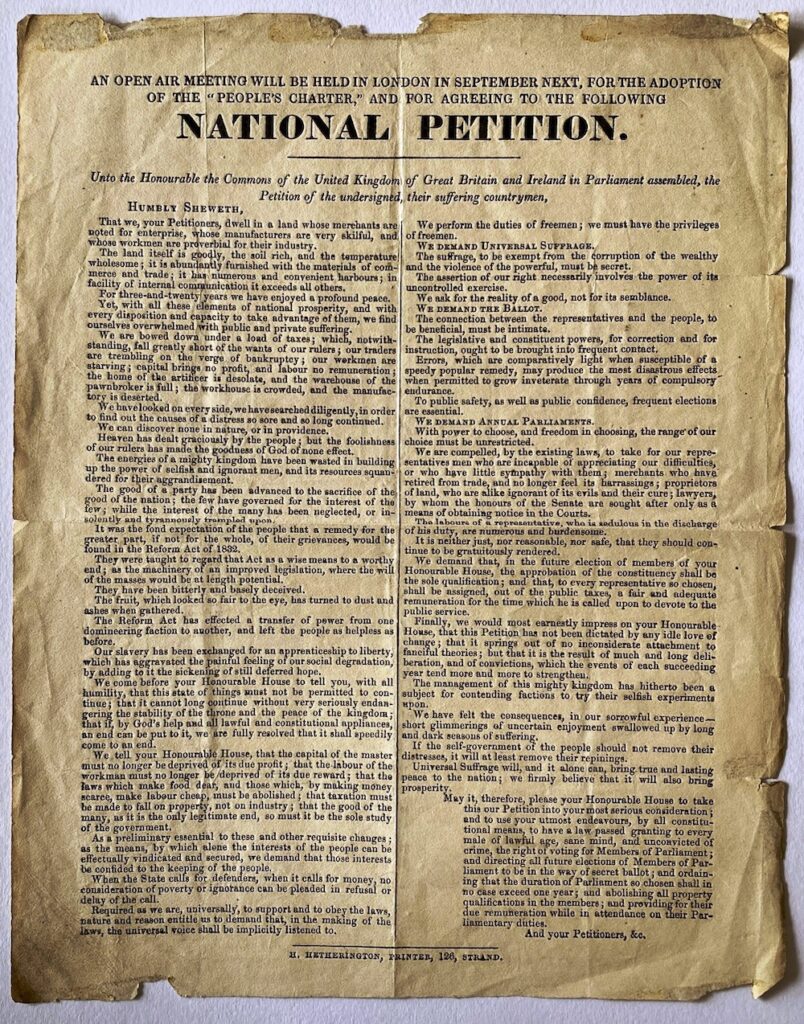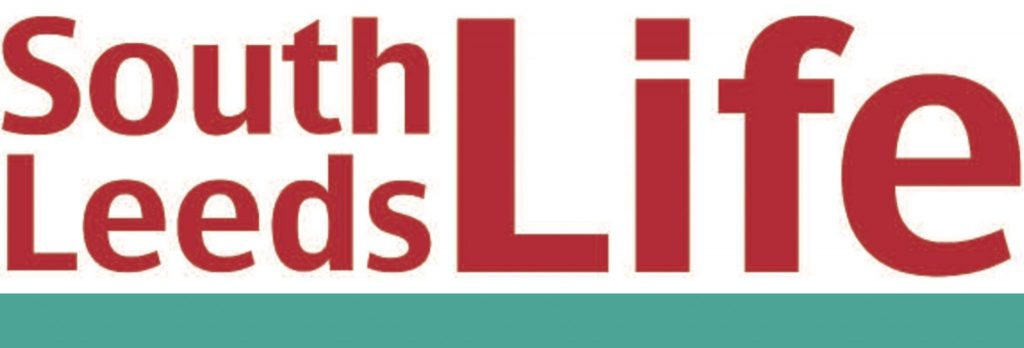
Chartists were followers of a political movement for reform spanning the years 1836 to 1849 taking its name from the 1838 Peoples Charter. They formulated their demands in a six point Charter: Universal (men’s) suffrage, Annual Parliaments, Vote by (secret) ballot, Abolition of the property qualification for MPs, Payment for MPs, and Equal size electoral districts.
The object was to make the Charter the law of the land by legal constitutional means if possible or by force if necessary or a mixture of both. The first climax of Chartism came in the winter of 1839 at the height of a trade depression and in 1842 the second peak of Chartist activity was reached with the Plug Riots arising from mass unemployment in the northern towns.
During the year 1842 trade of every kind was very much depressed and among the people there was widespread discontent and unhappiness. By the middle of August it had reached its height. In Carlisle a quarter of the population was dying of famine while in Stockport half the master spinners had failed and 5,000 workmen were walking the streets in compulsory distress. In Lancashire the distress was enormous and was further aggravated by a general turn out in several branches of trade.
In the principle towns of the West Riding the working classes had to endure many privations. At Leeds the pauper stone heap amounted to 150,000 tons, and the Board of Guardians offered the paupers 6 shilling (30p) per week for doing nothing, rather than 7 shillings and 6 pence (37½p) per week for breaking stone. The Poor Rates in Leeds had increased 50% leading the working classes to become turbulent and dissatisfied.
Formidable Chartist riots broke out in Lancashire and Yorkshire and it is said to have commenced first at Bayley’s Cotton Mill in Stalybridge. The power-loom weavers of that town were either unemployed or on strike compelling all other branches of trade in the town or its neighbourhood to follow their example.
Most of the principle towns in Lancashire caught the mood and in Manchester about 150 cotton mills besides an equal number belonging to other trades that usually employed some 50,000 hands were forced to stop work and the rioters in many cases destroyed valuable machinery.
By the middle of August the trouble had spread to Yorkshire. Holmfirth, Dewsbury, Huddersfield, Halifax, Bradford, Leeds, and other towns were scenes of riotous behaviour. On the morning of 17 August great excitement prevailed in Leeds from a report that a huge number of rioters were on the road from Bradford. Leeds was well organised with troops and a large number of Special Constables had been sworn in; perhaps knowing this fact the rioters confined their operations to the villages west of the town. At Stanningley they stopped the mill of Mr John Varley and forced the workpeople to leave the premises. They then proceeded to Bramley and closed all the mills in that village, including the large establishment of Mr John Haley. It was then onto Fulneck where they stopped the mill of Messrs Field and what was worse let off the water in the reservoir. The mob then divided into parties and went to the mills at Armley, Wortley, Farnley, etc which they caused to be closed.
In the meantime a large mob had assembled at Hunslet and commenced operations by turning out the hands of Petty’s Potteries at the bottom of Beeston Hill; after which they went along Holbeck Moor to the mills in Holbeck. They forced the boiler plug and summoned the hands out of the mill of E & G Tatham in Holbeck Lane. They did the same thing to several other mills in the area until they arrived at the large establishment of Marshall’s Mill.
The vicinity of the new mill in Marshall Street was completely crammed with an excited mob, many of who were armed with bludgeons, stones, etc. The yard door leading to the boiler room of the new mill was strongly barricaded and defended by Mr JG Marshall and a number of workmen but the mob by repeated efforts forced down the door and rushed into the yard. However, they did not find the plug of the boiler and consequently did not succeed in stopping the mill and left the premises without having done any serious mischief.
The mob then proceeded to the mill of Titley, Tatham & Walker in Water Lane which they had decided to stop when Prince George with the Lancers came up at full speed and formed a line in Campfield. The Riot Act was read and two or three of the ringleaders were taken prisoner. A party of Lancers, a party of Fusiliers and one or two Troops of Yorkshire Hussars commanded by Colonel Beckett, with a body of Police headed by one or two Magistrates were also stationed on Victoria Bridge.
The crowd, in the presence of the military showed no symptoms of being militant beyond the excitement of a mob. Prince George withdrew his troops to the Court House.
No sooner had the military gone when a considerable mob went in the direction of Meadow Lane where they burst in the boiler plug of Benyon’s Flax Mill and compelled the workpeople to leave the premises before the mob then proceeded to the factory of Maclea & March, machine makers, Dewsbury Road end. A party of Police and Special Constables were soon on the scene and had to use force to prevent the rioters doing damage; showers of stones flew over heads of the police and Mr Read, the Chief Constable showed courage in keeping a number attacking him at bay.
Prince George arrived with his Lancers and other troops restored the peace and shortly after this affray 38 prisoners were marched to the Court House and quickly examined by the Magistrates. Four prisoners were bound over to keep the peace and fined £5 each; three were bound over to keep the peace and three were discharged while the rest were committed for trial at York also as were 14 others for having been charged with rioting at Churwell, Beeston Royds Mill and other places. A Special Commission sat at York to try the rioters.
The Leeds rioters were tried on 3 September 1842, most of the prisoners were found guilty and sentenced to terms of imprisonment varying from 18 months downwards. The military in Leeds refrained from firing on the mob and so ended the Chartist Riots in Leeds. Several persons received wounds but no lives were lost and considering all the excitement no very serious damage was done to property.
Some idea of the preparations made by the authorities in Leeds for the suppression of the disturbance can be gathered from the fact that 30,000 staves had been provided for the Special Constables, the streets were cleared early in the evening and Public Houses were forced to close at eight o’clock while a large number of Police and Special Constables were on duty for the whole night. Two thousand persons suffered imprisonment for being concerned in the riots in the County of York. Mr Feargus O’Connor, Mr Julian Harney and other Chartist leaders were convicted after long and expensive trials of promoting riots, but ultimately in June 1843, succeeded in obtaining an Arrest of Judgement in the Court of the Queens Bench.

While you’re here, can we ask a favour?
South Leeds Life is published by a not-for-profit social enterprise. We keep our costs as low as possible but we’ve been hit by increases in the print costs for our monthly newspaper which have doubled in the last two years.
Could you help support local community news by making a one off donation, or even better taking out a supporters subscription?
Donate here, or sign up for a subscription at bit.ly/SLLsubscribe


